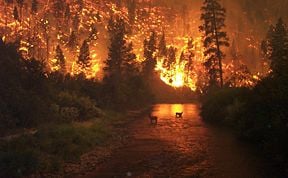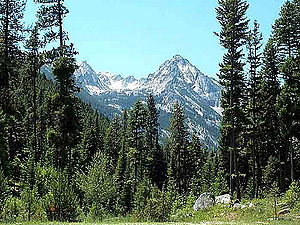Bitterroot National Forest
| Bitterroot National Forest | |
|---|---|
| IUCN Category VI (Managed Resource Protected Area) | |
| | |
| Location: | Ravalli and Missoula counties in Montana; Idaho County in Idaho, USA |
| Nearest city: | Missoula, MT |
| Area: | 1.6 million acres (6,500 km²) |
| Established: | 1907 |
| Governing body: | U.S. Forest Service |
Bitterroot National Forest comprises 1.6 million acres (6,500 km²) in west-central Montana and eastern Idaho, of the United States.
Founded in 1898, the forest is located in the Bitterroot and the Sapphire mountain ranges with elevations ranging from 2,200 feet (650 m) along the Salmon River in Idaho to 10,157 foot (3,100 m) Trapper Peak. Roughly half the forest (743,000 acres, 3,000 km²) make up part or all of three distinct Wilderness areas. These areas include the Anaconda-Pintler, Selway-Bitterroot and Frank Church River of No Return Wildernesses. The distinction is that in wilderness areas, no roads, logging, mining or other construction is permitted and all access must be done either on foot or horseback; even bicycles are not permitted. Hunting however is allowed forest-wide including wilderness areas.
History
The Lewis and Clark Expedition passed through parts of what are now forest lands in 1805. After the discovery of gold in Idaho and then Montana in the 1860's, numerous mining towns were built, some of which today are ghost towns. The Nez Perce National Historic Trail passes through a portion of the forest, following the route of the retreating Nez Perce on their historic path that led from Idaho to north central Montana in 1877. Heavy logging and other resource depletion beginning in the 1880's led conservationists to push for the preservation the forest.[1]
The Bitter Root Forest Reserve was established by the General Land Office on March 1, 1898 with 4,147,200 acres (16,783 km²). It was transferred to the U.S. Forest Service in 1906. On July 1, 1908 the name was changed to Bitterroot National Forest, with lands added from Big Hole National Forest and Hell Gate National Forest. Other lands were transferred from Biterroot to Beaverhead, Clearwater, Nez Perce and Salmon National Forests. On October 29, 1934 part of Selway National Forest was added.[2]
Composition
The forest is a combination of both grasslands and forested zones. Grazing rights are leased to private landowners in the lower altitudes where grasses and shrublands are dominant. Higher up, Douglas fir, larch, and lodgepole pine slowly give way to Engelmann Spruce and whitebark pine as the altitude increases. Above the treeline at 8,000 feet (2,400 m) the trees abruptly end and alpine flowers and grasses are found. A small grizzly bear population is located in the wilderness zones of the forest with black bear, mountain goat, bighorn sheep, elk and moose found forestwide. An active effort to reintroduce the grizzly bear to the region concluded in 2000 with a plan to release 25 bears into the wilderness zones over a five year period beginning in 2003.[3]
There are 1,600 mi (2,500 km) of trails and 18 improved campgrounds within the forest. Outstanding fishing is found in the dozens of rivers and streams and lakes. The forest headquarters is located in Hamilton, Montana. The largest nearby city is Missoula, Montana. The scenic Blodgett Canyon is but one of many steep canyons located in the forest. U.S. Highway 93 passes through portions of the forest.
ReferencesISBN links support NWE through referral fees
- ↑ Wilderness.net. Selway-Bitterroot Wilderness. The National Wilderness Preservation System. Retrieved 2006-07-08.
- ↑ Davis, Richard C. (September 29, 2005),
 PDF, The Forest History Society
PDF, The Forest History Society
- ↑ U.S. Fish and Wildlife Service. Record of Decision and Final Rule for Grizzly Bear Recovery in the Bitterroot. Retrieved 2006-07-08.
External links
- Bitterroot National Forest - U.S. Forest Service
- USGS Gird Point (MT) Topo Map - TopoQuest.com
- Bitterroot National Forest Recreation
Credits
New World Encyclopedia writers and editors rewrote and completed the Wikipedia article in accordance with New World Encyclopedia standards. This article abides by terms of the Creative Commons CC-by-sa 3.0 License (CC-by-sa), which may be used and disseminated with proper attribution. Credit is due under the terms of this license that can reference both the New World Encyclopedia contributors and the selfless volunteer contributors of the Wikimedia Foundation. To cite this article click here for a list of acceptable citing formats.The history of earlier contributions by wikipedians is accessible to researchers here:
The history of this article since it was imported to New World Encyclopedia:
Note: Some restrictions may apply to use of individual images which are separately licensed.



